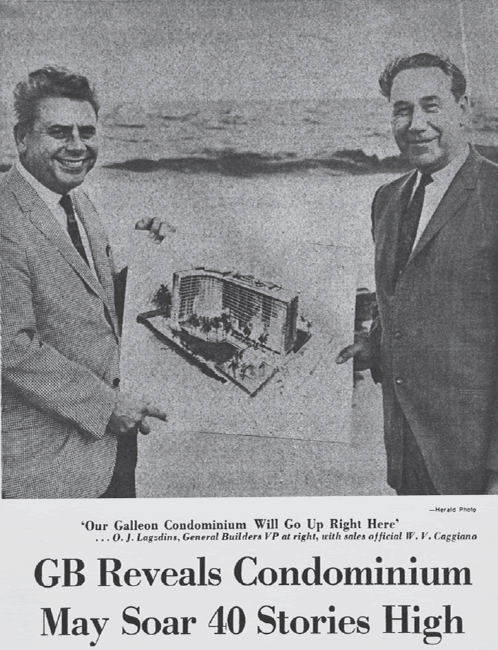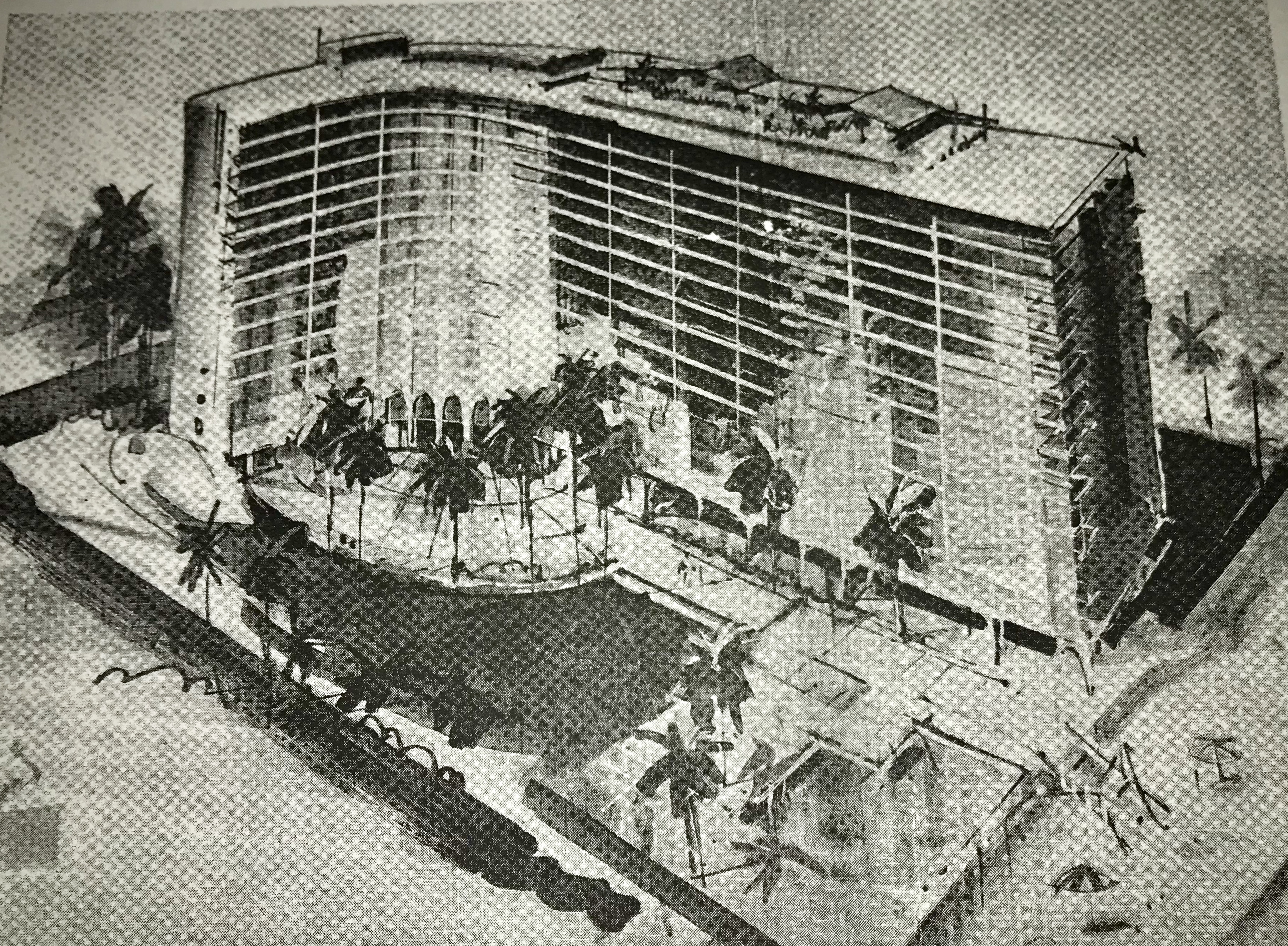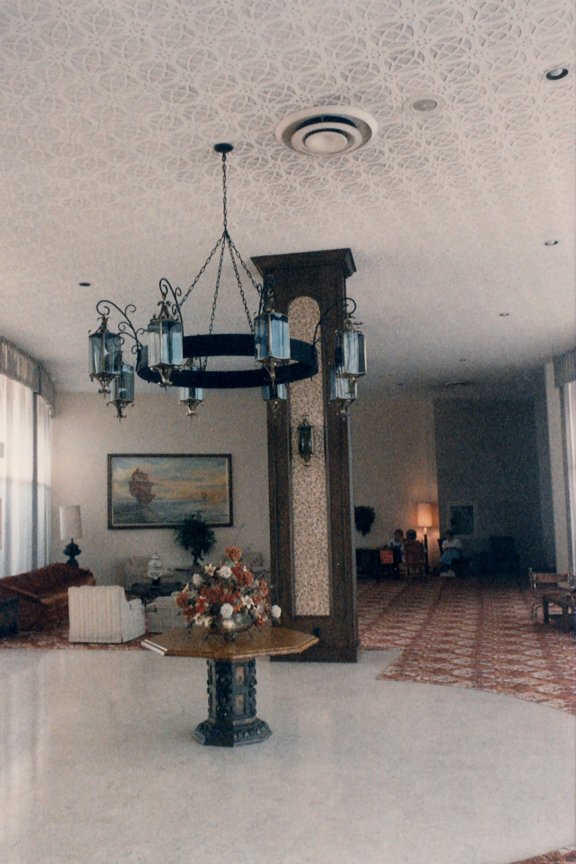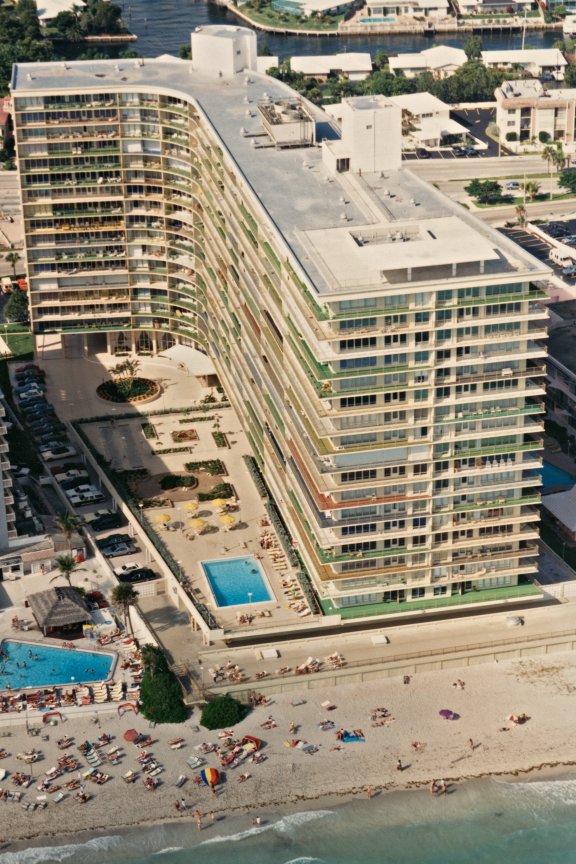The Galleon
Our Building's History






An article in the Sunday, Nov. 7, 1965 issue of the Miami Herald announced that a new building project was set to begin on Galt Ocean Mile. This was to be The Galleon, a “sister” to The Commodore, which had just been completed at the other end of the boulevard; it too was a project of General Builders, a South Florida construction company founded and managed by immigrants from Latvia.
The 18 story building, with 200 ft. of beachfront, would be shaped like a capital “J,” a unique design created to allow the maximum number of units to have ocean views. The article stated that as many as 10 different floor plans might be offered, and that a “recreation deck” was planned for the roof. By the end of January, 1966, 53 apartments had been purchased, pre-construction, mainly by buyers from Chicago, Detroit, New York, and other northern cities. Unit prices ranged from $21,000 to $60,000, with an expected completion date of June 1967; ground was broken at the site in May, 1966.
The building design was by Harold Liebman and Associates of New York. Liebman was a protégé of Morris Lapidus, whose designs for Miami’s Fontainebleau Hotel (1954) and Eden Roc Resort (1956) were derided by critics for their flashy opulence (Lapidus titled his autobiography Too Much is Never Enough), but adored by hotel guests who were there to live out fantasies and just get away from it all. The lobby of his Americana Hotel in Manhattan was described by one critic as looking like “an exploding gilded eggplant,” but guests were wowed. Liebman called his own design for The Gal¬leon “basically, South American modern.”
The modernist exterior design did not carry into the building’s other design elements. At the April 1967 “topping off” ceremony, attended by 100 owners and others, there was a display by Treasure Salvors Corp. of a portion of the $8 million worth of sunken Spanish treasure found off the Florida coast the previous three years; guests put their names in a special treasure chest and during welcoming remarks by General Builders’ vice-president in charge of the project, O.J. Lagzdins, a winner was chosen to receive a real “piece of eight” coin. In August, the Fort Lauderdale News and Sun-Sentinel reported that a sales room was soon going to be constructed at the building site, “an authentic reproduction of a massive, square-ended poop deck of a Spanish galleon,” to be reached by a gangway and ornamented with lamps “that are exact copies of those from a Spanish treasure galleon of centuries ago.” The two-story lobby of the apartment tower (also seen at Liebman/General Builders’ Point of Americas project) was to have an “indoor-outdoor” feeling with the colors of tropical plants contrasting with “the materials of the tiles and earth tones.” One would enter The Galleon into “a rotunda area covered with Italian Perlato marble and surrounded by plush carpeting, four unusual paneled columns accenting the lobby area,” with a hand-wrought Spanish chandelier overhead. To the right there would be a circular structure finished with dark brown “wormy chestnut” paneling within which would sit the security desk and offices. The promotional materials that were produced carried the Spanish theme through. Seven model units were open for inspection, and buyers could choose from thirteen different floor plans.
By the summer of 1968, more than 75% of the 214 apartments had been sold, according to sales manager W.V. Caggiano, and The Galleon was going up much faster than usual for a hi-rise. O.J. Lagdzins, explained in an interview with a reporter that a new construction technique called “critical path method,” jointly developed by the chemical and defense industries after the war – “a method of programming sequential and parallel activities” – was the reason. For example, rather than waiting for the electricians to finish up work on a floor, which could take a week or more, the masons would start work a day after the electricians. Nearing completion, The Galleon’s outside corridors on the north and west sides were protected by golden screens of anodized aluminum, while the balconies on the south side of the building had aluminum railings coated with golden baked enamel [the building must have glowed in the sun]. The 18-story aluminum screen, 250 feet in length and covering more than 32,000 sq. ft. was engineered and assembled in Oklahoma City; it was to be The Galleon’s most distinctive feature, thanks to Harold Liebman and General Builders. One newspaper called The Galleon an “eye-stopper” on the Galt. General Builders disclosed that over $7,600,000 had gone into the construction of The Galleon. Owners began moving in that fall.
Sometime after February, 1986, major changes were made to the lobby. New furniture replaced the heavy Spanish pieces, the Spanish chandelier and sconces were removed to make way for ones of crystal, and the “wormy chestnut” paneling of the circular security desk/office space was resurfaced with mirrored glass. A free-standing security desk was built. New marble flooring was put down in the entire lobby area to the east elevators and drapery panels went up. The gold aluminum railings on the balconies on the south side of the building were replaced with metal railings painted to match the color of the building. New pavers were installed around the pool.
In October 2005, Hurricane Wilma, which struck Florida from the Gulf of Mexico, caused $19 billion in property damage to the state, and extensive damage to The Galleon. The storm took South Florida by surprise, and many people failed to evacuate the barrier beach. Residents who remained in The Galleon recall hunkering down behind their storm shutters and hearing through the roar of the wind flying debris crash into the building as mini cyclones ripped through the Galt hi-rises. Electricity was out for days, no a.c. or elevators; even people living on the higher floors made the arduous trek by the stairs to fetch water from the pool in order to flush their toilets. Damage was done by wind and water to the cooling tower and roof, to the lobby and Armada Room, and to the catwalk elevator lobby doors; worse, The Galleon’s distinctive golden screen was also heavily damaged. After the damage to the building was assessed, a $600,000 assessment was levied on owners to cover the insurance deductible; then, when repair costs soared and The Galleon’s insurance carrier went bankrupt, a second $180,000 assessment was required to go with a new insurance carrier. In 2007, the contractor who had agreed to repair the screen went bankrupt, and the board decided to replace the screen with metal railings like the ones on the balconies. The Galleon’s 18-story golden screen, described by one architecture critic, in retrospect, as a “gilded mesh birdcage… with an aura of space-age optimism,” was history.
In 2007, the landscaped circle was replaced by fountain. In 2010, a $3,000,000 special assessment was passed to fund multiple projects, including concrete and balcony restoration, front area paving, landscaping and signage, and the construction of a modern fitness center with windows onto the pool deck. These projects were completed in 2012.
Board leadership and association sentiment over the years has gone back and forth between those favoring a policy of fiscal conservatism (a reluctance to address building needs beyond maintenance}, and owners willing to invest in the property; in 2016 owners voted, after fifty years, to institute a partial reserve fund. As The Galleon confronts basic big ticket items such as replacement of the elevators, and cheaper but more subjective and controversial ones such as the renovation of the lobby and common areas of the building, this yin and yang dynamic is likely to continue into the future. But whatever the future holds (one hates to mention threats posed by global warming), The Galleon will “sail on.”
